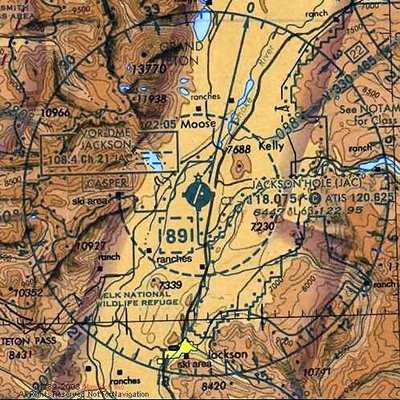Factual Information Released By The Safety Board
In its continuing investigation of the runway overrun of a
jetliner in Jackson Hole, Wyoming, the NTSB has developed the
following factual information:

At about 1138 MST on Wednesday, December 29, American
Airlines flight 2253, a B-757-200 (N668AA) inbound from Chicago
O'Hare International Airport, ran off the end of runway 19 in snowy
conditions while landing at Jackson Hole Airport. No injuries were
reported among the 181 passengers
and crew on board.
Instrument Flight Rules (IFR) weather conditions prevailed
around the time of the incident with a ceiling of 400 feet, light
snow and visibility of 1 mile. Winds were 10 knots from 240
degrees. Runway friction measurement data obtained before and
after the event have been provided by the Jackson Hole Airport
Authority for further evaluation by the NTSB.
In the continuing investigation, work groups have been formed to
examine the subject areas of air traffic control, airports,
meteorology, flight crew operations, airworthiness, maintenance
records, cockpit voice recorder (CVR), flight data recorder (FDR),
and airplane performance.
The NTSB systems investigator conducted testing on the incident
airplane from December 31, 2010, through January 6, 2011.
Operational testing and examination was accomplished on the
spoiler/auto speed brake, air/ground, autobrake, and thrust
reverser systems. No discrepancies were found in the
air/ground, autobrake, and thrust reverser systems. Examination of
the auto speed brake mechanism in the cockpit pedestal found that
the linear actuator aft attachment was improperly installed and was
missing a bushing. This loose connection allowed the cam to be
rotated slightly relative
to the switch, which could cause the switch roller and the notch in
the cam to not always align. System operation with this condition
present is being investigated.
The maintenance group convened at the American Airlines facility
in Tulsa, Oklahoma, to review airplane logbooks. The group focused
primarily on the spoiler/speed brake, air/ground, and thrust
reverser systems. No significant issues with any of these systems
were recorded prior to the incident, and there were no open minimum
equipment list (MEL) items at the time of the incident. The
airplane was manufactured in June 1992 and, at the time of the
incident, had accumulated 58,879 hours and 20,518 cycles. No
discrepancies were noted during the last periodic service
maintenance check conducted on December 26, 2010. The last heavy
maintenance was accomplished in October 2005. The auto speed brake
actuator was replaced in January 2008.

Jackson Hole Sectional
The CVR group convened on January 4, 2011, at the NTSB recorder
laboratory. The group completed a transcript of the last 30 minutes
of the recording and a summary of the previous 90 minutes. The
transcript will be released when the public docket is opened.
The FDR group has begun the process of determining which of the
documented parameters are installed and should be functional, and
is checking the recorded data for validity. The group has verified
the following factual information:
- The FDR download contains the last 43.9 hours of data, more
than the required 25 hours, and includes all of the incident
flight.
- The recorded speed brake handle position indicates that the
speed brakes were manually extended by the flight crew during the
approach after which the handle was left in the armed position
until landing. The FDR records only the speed brake handle position
and not the individual speed brake (spoiler) panel positions.
- The FDR data indicate that the aircraft touched down at
approximately 132 knots.
- At touchdown, the air/ground parameter changes to "ground" for
approximately one second and then switches to "air" for
approximately ½ second before
- changing back to "ground" for the remainder of the
recording.
- During the time period when the air/ground parameter switched
back to "air," the speed brake handle position momentarily moved
toward the down position and then returned to the armed position
where it stayed for the remainder of the recording.
- Thrust Reverser (T/R) discrete parameters indicate that the
T/Rs moved into the in-transit position during the ½ second
that the air/ground logic parameter indicated "air."
- The T/Rs remained in the in-transit position for approximately
10 seconds before transitioning to the stowed position for one
second. The T/Rs then moved back to the in-transit position
for an additional 6 seconds before becoming deployed.
- The T/R discrete parameters indicate that approximately 18
seconds elapsed from the time the T/Rs began moving until they were
fully deployed.
Additionally, the team has examined security camera videos
provided by the airport as well as a video of the landing taken by
one of the passengers.
 ANN's Daily Aero-Term (04.26.24): DETRESFA (Distress Phrase)
ANN's Daily Aero-Term (04.26.24): DETRESFA (Distress Phrase) ANN's Daily Aero-Linx (04.26.24)
ANN's Daily Aero-Linx (04.26.24) Airborne 04.22.24: Rotor X Worsens, Airport Fees 4 FNB?, USMC Drone Pilot
Airborne 04.22.24: Rotor X Worsens, Airport Fees 4 FNB?, USMC Drone Pilot Airborne 04.24.24: INTEGRAL E, Elixir USA, M700 RVSM
Airborne 04.24.24: INTEGRAL E, Elixir USA, M700 RVSM Airborne-NextGen 04.23.24: UAVOS UVH 170, magni650 Engine, World eVTOL Directory
Airborne-NextGen 04.23.24: UAVOS UVH 170, magni650 Engine, World eVTOL Directory




